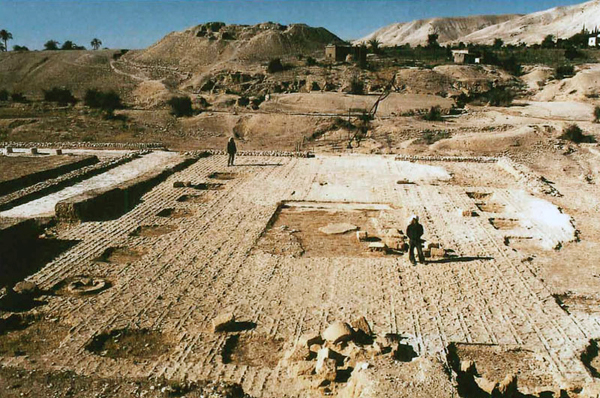The discovery of colored floor tiles found in the Temple Mount Sifting Project, that apparently came from the Herodian Temple Mount was announced during the 17th Annual Archaeological Conference in the City of David National Park held on the 8th of September 2016. This new find received plenty of media coverage, see for example this Jerusalem Post report. As usual the reporting took the form of copying and pasting the original report.
First of all, kudos to Frankie Snyder for having patiently fitted these many pieces together into meaningful designs. The stones have different geometrical shapes, were finely cut and polished and fitted tightly together to create beautiful designs. Such floor designs are called opus sectile, which is Latin for “cut stone”.

I wanted to be sure, however, that what was presented could indeed have belonged to floors or pavements on the Temple Mount. When I first saw the pictures of Frankie’s floor designs, they reminded me of the beautifully designed tiled floors of the late nineteenth century house in Ethiopia Street in Jerusalem where we used to live. These floor designs have been used for a very long time. For example, many pieces of Crusader and earlier stone floor designs were found during the sifting, see here.
Looking at the photographs presented by the TMSP, however, I wondered why some tiles looked like marble:


Hardly any marble was imported into Israel until the time of Hadrian. In 135 AD, he established a Roman colony called Aelia Capitolina, on the ruins of Jerusalem, which had been destroyed in 70 AD. Evidence of the use of marble has been found from this period. For example, in the Temple Mount Excavations a Roman bath house with a marble-lined pool was uncovered, together with a marble statue.
So, I asked Frankie what materials these reconstructed tiles were made of, she replied that, apart from locally sourced stone, different types of imported marble were also used, such as giallo antico from Tunisia, breccia corallina from Turkey, breccia di Settebasi from Greece and also alabaster from Egypt.
It was interesting to find out that the opus sectile pavement found in Herod’s Third Palace in Jericho also had pieces of marble worked into its design. Herod was a great lover of Roman art and architecture and apparently imported these tiles from around the Mediterranean.

Gabriel Barkay, one of the directors and co-founders of TMSP is sure of the Herodian date of the tiles they found:
“The materials of which they are made, colorful marble-like stones which originate from different locations and places around the basin of the Mediterranean. They were neither imported before the time of Herod the Great nor later, so we are sure of the date … Opus Sectile flooring is consistent with the style of flooring found in Herod’s palaces at Masada, Herodium, and Jericho, among others, as well as in majestic palaces and villas in Italy during the time of Herod. The tile segments, mostly imported from Rome, Asia Minor, Tunisia and Egypt, were created from polished multicolored stones cut in a variety of geometric shapes.”
Indeed, an opus sectile floor was found in the Peristyle Building in the Jewish Quarter Excavations. This was made of black bitumen and cream and red colored limestone.

The question that remains unanswered is, where on the Temple Mount were such floors laid? The description of Josephus in War 5.193 was quoted: “The open court was from end to end variegated with paving of all manner of stones.” Does this refer to these opus sectile floors?
Herodian paving on the Temple Mount has been identified by us and reported on previously. These in situ remains show that the open courts of the Herodian Temple Mount were paved with very large and thick paving slabs made of local limestone, very similar to those laid in the streets that surround the Temple Mount.
All the known opus sectile floors were laid indoors and not outdoors. These delicately constructed floors would not have survived long outside in the sometimes harsh Mediterranean climate. We suggest therefore that they came from the interior of some of the many buildings that surrounded the Temple and/or from under the colonnades around the smaller courts.


On the chronology, wouldn’t it have been possible for Agrippa I or Agrippa II to import marble in the 50’s or 60’s CE?
Bill,
It would be theoretically possible, but no evidence has been found. Apart from some household items no marble was imported on a large scale during the Herodian period. Those opus sectile floors which have marble in them were laid exclusively during that small window of time of the reign of Herod the Great.
Or maybe Hadrian’s opus sectile flooring contained pieces from Herod’s opus sectile flooring mixed with new material ? That is, the Temple is still there, on the Temple mount today, in thousand pieces ?
Emma,
That is an interesting suggestion. However, there is so much marble in Italy that I doubt if the Romans needed the broken tiles from Jerusalem.